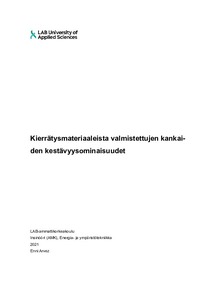Kierrätysmateriaaleista valmistettujen kankaiden kestävyysominaisuudet
Arvez, Enni (2021)
Arvez, Enni
2021
All rights reserved. This publication is copyrighted. You may download, display and print it for Your own personal use. Commercial use is prohibited.
Julkaisun pysyvä osoite on
https://urn.fi/URN:NBN:fi:amk-202104296286
https://urn.fi/URN:NBN:fi:amk-202104296286
Tiivistelmä
Opinnäytetyössä selvitettiin kierrätysmateriaaleista valmistettujen kankaiden kestävyysominaisuuksia. Tutkittavana oli eri yrityksiltä saadut kuusi kangasta. Niiden soveltuvuutta erilaisiin käyttötarkoituksiin arvioitiin tulosten perusteella. Toimeksianto työhön saatiin Telaketju2-hankkeelta.
Työ jakaantui teoriaosuuteen sekä kokeelliseen osioon. Teoriaosuus keskittyi tekstiilin kierrätykseen sekä sen ominaisuuksiin ja laatuun. Kokeellinen osio koostui kankaiden laboratoriotestauksesta sekä tulosten raportoinnista ja analysoinnista.
Tutkimustuloksia verrattiin kankaiden laatusuosituksiin. Vertailun perusteella testattujen kankaiden käyttöä vaatetustarkoituksiin tulisi tutkia lisää. Kankaiden lujuus- ja repeämisominaisuudet olivat hyvällä tasolla, mutta ne kutistuivat loimen suuntaan huomattavasti. Suurin osa kankaista nyppyyntyi helposti. Kankaiden epätasainen laatu näkyi monen kankaan kohdalla niistä leikattujen rinnakkaisnäytteiden tulosten vaihteluna. Testit antoivat alustavia tuloksia, joiden pohjalta voidaan suunnitella uusia tutkimuksia kierrätyskankaille, miettiä niille käyttökohteita sekä jatkaa niiden ominaisuuksien kehittämistä haluttuun suuntaan. The aim of the thesis was to investigate the durability properties of fabrics made from recycled materials. Six fabrics from different companies were studied. Based on the results, the suitability of the fabrics for different end uses was evaluated. The thesis was commissioned by the Telaketju2 Project.
The thesis was divided into a theory section and a study section. The theory section focused on textile recycling, textile properties and the quality of textiles. The study section consisted of fabric laboratory testing, as well as reporting and analyzing the results.
The study results were compared to quality recommendations for fabrics. Based on that comparison, the suitability of fabrics for clothing purposes should be studied more. The tensile and tear properties of the fabrics were at a good level, but they shrank considerably in the warp direction when washed. Most of the fabrics became pilled easily. There were differences in some of the results between the samples cut from a fabric, which showed the uneven quality of the fabrics. The tests gave preliminary results that can be utilized as a basis for later studies, as well as for finding end uses for fabrics made from recycled materials and keeping on developing their properties in the desired direction.
Työ jakaantui teoriaosuuteen sekä kokeelliseen osioon. Teoriaosuus keskittyi tekstiilin kierrätykseen sekä sen ominaisuuksiin ja laatuun. Kokeellinen osio koostui kankaiden laboratoriotestauksesta sekä tulosten raportoinnista ja analysoinnista.
Tutkimustuloksia verrattiin kankaiden laatusuosituksiin. Vertailun perusteella testattujen kankaiden käyttöä vaatetustarkoituksiin tulisi tutkia lisää. Kankaiden lujuus- ja repeämisominaisuudet olivat hyvällä tasolla, mutta ne kutistuivat loimen suuntaan huomattavasti. Suurin osa kankaista nyppyyntyi helposti. Kankaiden epätasainen laatu näkyi monen kankaan kohdalla niistä leikattujen rinnakkaisnäytteiden tulosten vaihteluna. Testit antoivat alustavia tuloksia, joiden pohjalta voidaan suunnitella uusia tutkimuksia kierrätyskankaille, miettiä niille käyttökohteita sekä jatkaa niiden ominaisuuksien kehittämistä haluttuun suuntaan.
The thesis was divided into a theory section and a study section. The theory section focused on textile recycling, textile properties and the quality of textiles. The study section consisted of fabric laboratory testing, as well as reporting and analyzing the results.
The study results were compared to quality recommendations for fabrics. Based on that comparison, the suitability of fabrics for clothing purposes should be studied more. The tensile and tear properties of the fabrics were at a good level, but they shrank considerably in the warp direction when washed. Most of the fabrics became pilled easily. There were differences in some of the results between the samples cut from a fabric, which showed the uneven quality of the fabrics. The tests gave preliminary results that can be utilized as a basis for later studies, as well as for finding end uses for fabrics made from recycled materials and keeping on developing their properties in the desired direction.
